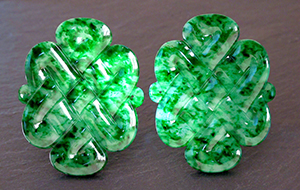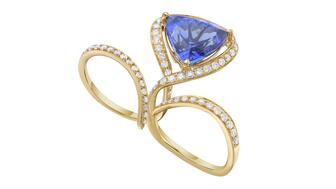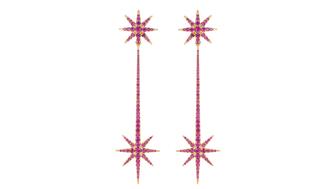Carlos Jose Hernandez and Joshua Zuazo were sentenced to life without the possibility of parole in the 2024 murder of Hussein “Sam” Murray.
Rocks On: Jadeite prices up, even as US ban goes on
This edition of Rocks On examines how the U.S.’s ban on the import of jadeite from Myanmar has affected the gemstone in the American market.

With a ban currently in place that prohibits the import of jadeite mined in Myanmar (formerly known as Burma) to the United States, American gem dealers must work with what they’ve already got or explore new avenues.
The problems in Myanmar can be traced back to the 1962 military coup that ended democratic rule in the country and marked the military junta’s rise to power. Since then, there has been widespread human rights abuses as well as oppression of any democratic opposition.
The extent of the issues really came to light for the international community in 2007, when the military regime--then known as the State Peace and Development Council--cracked down on a peaceful revolution for democratic reform with violence, leading to the death of hundreds of unarmed protesters and thousands more being detained, imprisoned, beaten or tortured.
The U.S. government originally put sanctions on ruby and jadeite from Myanmar in 2003. The ban was tightened in 2008 with the passage of the Tom Lantos Block Burmese JADE (Junta’s Anti-Democratic Efforts) Act, which prohibited the importation of jadeite or rubies mined in Myanmar into the United States, no matter where they are cut.
And while many in the gemstone trade object to the ban, saying it hurts small-scale miners and dealers and does little to disrupt the junta, it doesn’t appear to be going away anytime in the near future.
President Barack Obama has lifted some of the sanctions against Myanmar during his presidency, but a few remain, including the ban on the import of jadeite.
(Though the terms jade and jadeite often are used interchangeably, jade is actually a broader term for two different minerals, jadeite and nephrite. Jadeite is the more expensive, finer material, and it is specifically jadeite that the ban mentions.)
For many, this has meant either entering the estate and vintage jewelry market to find old pieces of jadeite already in the country or working from an inventory that they built up before the ban was enacted.
Meanwhile, the prices for fine jadeite of all colors have all been moving in the
The supply side
As far as sources of fine jadeite go, Myanmar is pretty much it. Though there are a few other countries mining it, the material coming from elsewhere rarely is gem material that can be used in fine jewelry, leaving few options for jadeite suppliers.
“For us, this (ban) meant a shift to buying in the domestic market, which is second-hand estate pieces,” said Jeff Mason of jade wholesaler Mason-Kay, adding that he’s had to explore other avenues over the past few years, including jewelry stores, pawn shops and even consumers looking to sell old pieces.
Roland Schluessel of gem dealer Pillar & Stone said that though they are working mostly off the jadeite inventory they were able to build before the ban, they are open to buying high-quality estate pieces if they can find it.
Their location in San Francisco actually gives them an advantage, since the city has a strong history of dealing in jade, he said. Long before the ban and dating back to nearly a century ago, there was market for it in the city, Schluessel added, which has led to a stronger resale market than is found elsewhere in the country.
He added that the U.S. does have a strong estate market for jadeite when compared to that of France, Italy, Germany or England, where demand for the gemstone has been slower.
In addition to the ban creating problems for American dealers, there’s also the added concern in the jadeite market about how long the mines in Myanmar will last and what kind of supply will be left in the next decade or two, Mason said, driving prices up even more.
China’s buying power
Accounting for the same quality factors across the board, fine green jadeite is almost always the most expensive.
After that, both lavender jade and ice jade, which is colorless and can have an adularescence similar to moonstone, are becoming very popular and have been increasing in price. Red jade also has been gaining awareness and popularity over the last five to six years.
Schluessel described the difference in demand that he’s seeing among colors as such: Buyers are actively requesting fine green jadeite from him and go looking for it on purpose. Meanwhile, lavender jade might be something that they happen upon and end up liking and buying, but the request is not as active.
So, despite the higher price tags, fine green jadeite continues to be coveted. It is even seeing record prices at auction these days.
Last April, a jadeite bead necklace with a Cartier clasp sold for $27.4 million at Sotheby’s, crushing its pre-sale high estimate of $12 million and setting a new world record for any jadeite jewelry and Cartier jewel sold at auction.
Called the Hutton-Mdivani necklace, the piece boasts 27 jadeite beads of “magnificent green color, excellent translucency, extremely fine texture and majestic proportions,” according to Sotheby’s, ranging in size from 15.40 to 19.20 mm.
The question of supply in the international market continues to drive the price of fine jadeite high, and the main group who’s willing to pay those prices these days are Chinese buyers.
Not only has jade long been a part of Chinese tradition, but the rising upper class in the country has brought about a consumer segment willing to spend on luxury items, and they make up the strongest buying group currently when it comes to fine jadeite.
The necessary education
Interest in jadeite also has increased notably in Western markets over the past few years, especially as buyers start to learn more about the gemstone.
Designer Nikolai Tsang of Jade by Nikolai said that she’s seen a lot more education behind jadeite in the last five years, adding that she’s noticed a big difference in buyers’ knowledge levels about the gemstone at the last two AGTA shows in Tucson.
The majority of her demand comes from Western markets, which Tsang thinks could be because she’s stepped away from the more traditional flat, smooth designs to give her creations an updated look with 3D carvings so that people can really see the characteristics of the jadeite.
“The more contemporary look really speaks to the U.S. buyers,” Tsang said.
In addition to making sure that buyers understand what’s out there and the difference between the types of jadeite, another issue that has come up in the market surrounds treatments and disclosure, or, rather, the lack of it, Mason said.
He estimates that a majority of the jadeite supply that was coming into the United States before the ban had been treated in some way.
“As long as you disclose it, there’s nothing wrong with it,” he said. “But since there’s not a lot of knowledge (about the gem), there can be a lot of deceit. And sometimes it’s not deceit, it’s just that the source didn’t know it was even treated in the first place.”
This latter situation is much more common in the estate jadeite market, where pieces have been handed down and the original information about the gem and its quality gets lots somewhere in the transitions.
Though it might be less of a problem at the high end, where not much is needed to enhance those stones, treatments can have a substantial impact on what jadeite is worth.
An example Schluessel gave is a cabochon non-treated piece of Imperial jade--highly saturated green jadeite that is semi-transparent--which could be valued at around $1 million or more for a 20x13 mm piece in its natural state. If treated, it could end up being worth just $5.
“As soon as it’s treated, the value plummets,” he said.
The Latest

Yood will serve alongside Eduard Stefanescu, the sustainability manager for C.Hafner, a precious metals refiner in Germany.

The New Orleans jeweler is also hosting pop-up jewelry boutiques in New York City and Dallas.

How Jewelers of America’s 20 Under 40 are leading to ensure a brighter future for the jewelry industry.

Set in a Tiffany & Co. necklace, it sold for $4.2 million, the highest price and price per carat paid for a Paraíba tourmaline at auction.


The jeweler’s “Deep Freeze” display showcases its iconic jewelry designs frozen in a vintage icebox.

Take luxury gifting to new heights this holiday season with the jeweler’s showstopping 12-carat sphene ring.

Roseco’s 704-page catalog showcases new lab-grown diamonds, findings, tools & more—available in print or interactive digital editions.

This year's theme is “Unveiling the Depths of the Ocean.”

In its annual report, Pinterest noted an increase in searches for brooches, heirloom jewelry, and ‘80s luxury.

Starting Jan. 1, customers can request the service for opal, peridot, and demantoid garnet.

The 111-year-old retailer celebrated the opening of its new location in Salem, New Hampshire, which is its third store in the state.

The new catalog features its most popular chains as well as new styles.

The filmmaker’s personal F.P. Journe “FFC” prototype was the star of Phillips’ recent record-setting watch auction in New York.

The new location in the Design District pays homage to Miami’s Art Deco heritage and its connection to the ocean.

Inflations, tariffs, and politics—including the government shutdown—were among consumers’ top concerns last month.

“Longtime favorite” presenters, as well as first-time speakers, will lead talks and workshops at the annual event in Tucson next year.

Silas Smith of Meridian Metalworks won the challenge with his pendant that blends Australian and American landscapes.

The sale of the 31.68-carat, sunset-hued stone was part of Sotheby’s first series of events and auctions in Abu Dhabi.

Most customers who walk into your store this month have made up their minds. Your job is to validate their choice, Emmanuel Raheb writes.

The collection features characters and motifs from Ukrainian folklore, including an enchanted mirror and a magic egg.

MatrixGold 3.11, the newest version of the jewelry design program, offers more flexibility, precision, and creative control.

The pavilion will be part of the 2026 JA New York Spring show, scheduled for March 15 to 17.

Kadet, a 1994 National Jeweler Retailer Hall of Fame inductee, helped grow the family-owned retailer in the Chicago area and beyond.

Billed as the world’s smallest wearable, Lumia Health’s new smart earrings have a health tracker subtly embedded in the back.

Don’t let those with December birthdays feel blue. Help them celebrate their month with blue zircon, turquoise, and tanzanite.

The new pink sapphire version of the piece dances with its wearer in the brand’s “Icons After Dark” holiday campaign.

























